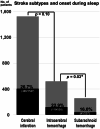Spontaneous Intracerebral Hemorrhage Occurring During Sleep: Clinical Characteristics and Risk Factors
- PMID: 40852057
- PMCID: PMC12370336
- DOI: 10.1055/s-0045-1806802
Spontaneous Intracerebral Hemorrhage Occurring During Sleep: Clinical Characteristics and Risk Factors
Abstract
Background: Ischemic stroke occurring during sleep has been known as wake-up stroke, and many studies have been conducted on the subject. On the other hand, there have only been a few studies on spontaneous intracerebral hemorrhage (ICH) occurring during sleep. To clarify their clinical characteristics and possible risk factors, a single-center retrospective study was conducted on nontraumatic ICH patients admitted to our institution between 2012 and 2017.
Materials and methods: Demographics and outcomes were compared between 119 patients with ICH occurring during sleep (sleep group) and 401 patients with ICH occurring during the awake period (awake group). Multivariate regression analysis was conducted to identify risk factors. Furthermore, clinical presentation in those 119 patients was further classified into three categories (deficits, sudden headache, and failure to wake up), and their association to the outcomes was evaluated.
Results: Compared with the awake group, the frequency of chronic kidney disease (CKD) and diabetes mellitus were significantly higher in the sleep group. Multivariate regression analysis identified CKD as a risk factor for ICH occurring during sleep. The in-hospital mortality rate was significantly higher in the sleep group. Among the three classifications, failure to wake up was indicative of high mortality rate.
>conclusion: The current results that ICH occurring during sleep was indicative of worse outcomes is compatible with prior studies. Poorly controlled nocturnal hypertension in patients with CKD and diabetes mellitus may be responsible for the higher incidence of ICH occurring sleep in those populations. The three classifications according to clinical presentation may be useful as a prognosticator.
Keywords: chronic kidney disease; diabetes; intracerebral hemorrhage; risk factor; sleep.
Asian Congress of Neurological Surgeons. This is an open access article published by Thieme under the terms of the Creative Commons Attribution-NonDerivative-NonCommercial License, permitting copying and reproduction so long as the original work is given appropriate credit. Contents may not be used for commercial purposes, or adapted, remixed, transformed or built upon. ( https://creativecommons.org/licenses/by-nc-nd/4.0/ ).
Conflict of interest statement
Conflict of Interest None declared.
Figures


Similar articles
-
Prescription of Controlled Substances: Benefits and Risks.2025 Jul 6. In: StatPearls [Internet]. Treasure Island (FL): StatPearls Publishing; 2025 Jan–. 2025 Jul 6. In: StatPearls [Internet]. Treasure Island (FL): StatPearls Publishing; 2025 Jan–. PMID: 30726003 Free Books & Documents.
-
Non-pharmacological interventions for sleep disturbances in people with dementia.Cochrane Database Syst Rev. 2023 Jan 3;1(1):CD011881. doi: 10.1002/14651858.CD011881.pub2. Cochrane Database Syst Rev. 2023. PMID: 36594432 Free PMC article.
-
The Black Book of Psychotropic Dosing and Monitoring.Psychopharmacol Bull. 2024 Jul 8;54(3):8-59. Psychopharmacol Bull. 2024. PMID: 38993656 Free PMC article. Review.
-
[Volume and health outcomes: evidence from systematic reviews and from evaluation of Italian hospital data].Epidemiol Prev. 2013 Mar-Jun;37(2-3 Suppl 2):1-100. Epidemiol Prev. 2013. PMID: 23851286 Italian.
-
Early referral strategies for management of people with markers of renal disease: a systematic review of the evidence of clinical effectiveness, cost-effectiveness and economic analysis.Health Technol Assess. 2010 Apr;14(21):1-184. doi: 10.3310/hta14210. Health Technol Assess. 2010. PMID: 20441712
References
-
- Peter-Derex L, Derex L. Wake-up stroke: from pathophysiology to management. Sleep Med Rev. 2019;48:101212. - PubMed
-
- Nagakane Y, Miyashita K, Nagatsuka K, Yamawaki T, Naritomi H. Primary intracerebral hemorrhage during asleep period. Am J Hypertens. 2006;19(04):403–406. - PubMed
-
- Liu J, Luo C, Hu C et al. Behavioral trigger factors for hemorrhagic stroke: a case-crossover study. Postgrad Med J. 2023;99(1175):1013–1019. - PubMed
LinkOut - more resources
Full Text Sources

